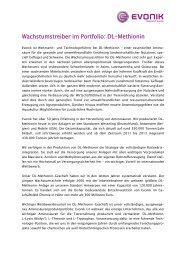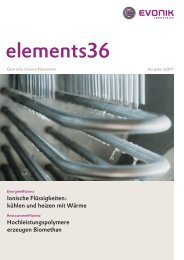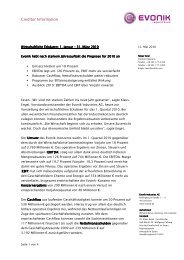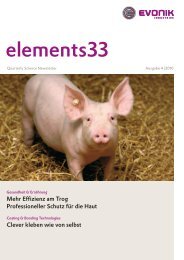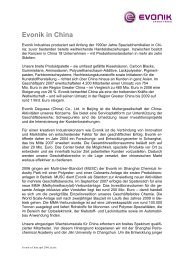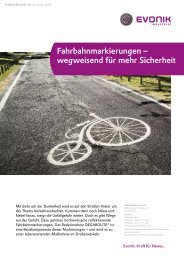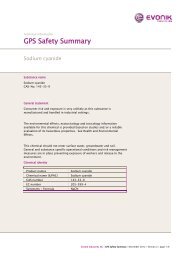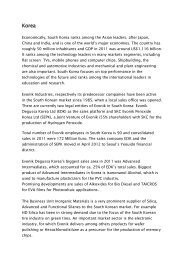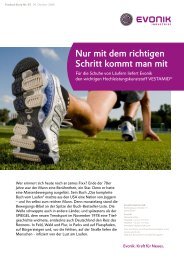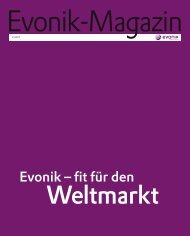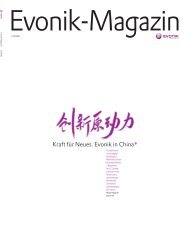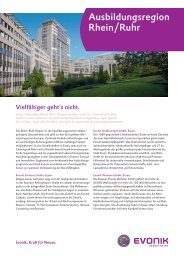Evonik Industries AG
Evonik Industries AG
Evonik Industries AG
You also want an ePaper? Increase the reach of your titles
YUMPU automatically turns print PDFs into web optimized ePapers that Google loves.
9 SEPTEMBER 21, 2010<br />
GLOBAL CORPORATE FINANCE<br />
currently in the process of selling a stake in the energy business), with the proceeds to be partly applied<br />
to debt reduction, should help to position the group’s debt metrics in line with an investment-grade<br />
rating over time. Moody’s notes that while pension liabilities are included in its debt adjustments, they<br />
exert less pressure on the capital structure of EI than financial indebtedness, given the absence of<br />
maturities and the lower level of net interest cost carried on these liabilities.<br />
... as well as a relatively aggressive dividend policy result in elevated debt metrics<br />
Moody’s notes that EI has historically returned material amounts of cash to its shareholders through<br />
the payment of sizeable dividends. Payout ratios have averaged more than 100% of the group’s net<br />
income over the past two years. Looking ahead, we expect EI to continue to pay large dividends.<br />
FIGURE 8<br />
EI has weaker credit metrics than its peers [1]<br />
EBITDA/ NET DEBT/<br />
RCF/<br />
FCF/<br />
RATING INTEREST EXP<br />
EBITDA NET DEBT NET DEBT<br />
<strong>Evonik</strong> <strong>Industries</strong> Ba1/sta 3.1x 4.8x 8.8% 10.9%<br />
Lanxess Baa2/sta 3.7x 2.9x 18.4% 19.8%<br />
Clariant Ba1/sta 3.0x 3.4x 26.2% 54.4%<br />
Akzo Nobel Baa1/sta 5.4x 2.1x 20.9% 22.2%<br />
[1] These figures are based on standard adjustments that Moody’s makes to enable global consistency for issuers reporting under IFRS. For details on<br />
these adjustments please refer to our rating methodology document “Moody’s Approach to Global Standard Adjustments in the Analysis of Financial<br />
Statements of Non-Financial Corporations - Part II”, published in February 2006.<br />
Ba score for “Financial Strength” rating factor reflects EI’s solid operating performance despite difficult market<br />
conditions ...<br />
Despite challenging market conditions especially during the first half of fiscal year 2009 with continued<br />
destocking patterns across the chemicals value chain and pressure on prices whilst most chemicals<br />
companies were still absorbing high raw material costs through their P&Ls, EI posted a robust<br />
operating performance. EI’s performance was supported by the strength of its chemicals franchise and<br />
the overall diversity of its business profile with exposure to chemicals, energy and real estate.<br />
In 2009, EI reported a decline in sales of 18% year-on-year to €13.1 billion. Both the group’s<br />
chemicals and energy businesses posted a sharp fall in sales (-15% and -25%, respectively), mainly on<br />
the back of lower volumes (-10% for the chemicals business), but also as a result of lower prices for<br />
the chemicals business (-6% year-on year). The real estate business fared well, with a 1% increase in<br />
revenues year-on-year.<br />
In the same period, EBITDA at the group level was down 6%, to €2.0 billion, lifting the EBITDA<br />
margin by 1.9 percentage points, to 15.5%, thanks to an over-proportional reduction in cost of goods<br />
sold (COGS, -20%) and the group’s implementation of cost-cutting measures including short working<br />
hours, optimised maintenance expenses, reduced external services and the streamlining of<br />
administrative functions. Selling, general and administrative expenses (SG&A) fell by 14%, as EI<br />
maintained a high level of R&D (€300 million) in order not to jeopardise its future developments in<br />
an industry that is evolving rapidly. In terms of divisional EBITDA performance, the chemicals<br />
business proved to be the most resilient through the downturn. This division posted a 1% decline in<br />
EBITDA, lifting its margin by 2.3 percentage points to 16.1%, mainly as a result of cost-cutting<br />
measures in H1 2009 (3,500 employees, or almost 12% of the division’s workforce, were working<br />
short hours) and high operating leverage when volumes improved in H2 2009. Meanwhile, the energy<br />
ANALYSIS: EVONIK INDUSTRIES <strong>AG</strong>



